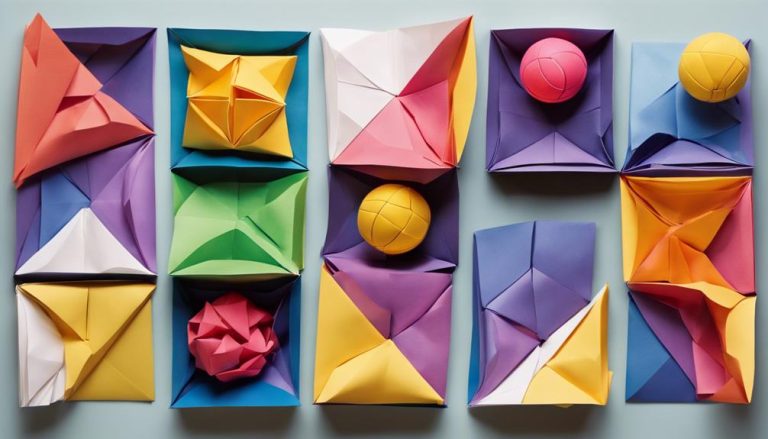General Rules of Goalball
In Goalball, teams of 3 players aim to score by rolling the ball into the opponent's goal area during two 12-minute halves. This indoor sport, played on a court with tactile markings, is designed for athletes with visual impairments. The rules emphasize fair play, team coordination, and strategic play. Understanding these fundamentals is key to success in the game. As you discover more about the intricacies of Goalball, you'll uncover additional strategies and tactics that can elevate your gameplay.
Court Dimensions
When setting up a goalball court, it is essential to adhere to specific dimensions to guarantee fair gameplay and adherence to regulations. Goalball courts are 18 meters long and 9 meters wide, with goal areas that are 3 meters deep at each end. The court is divided into six even sections, with tactile lines indicating player positions and movement zones. These lines help players orient themselves during gameplay, ensuring they stay within their designated areas.
Player movement in goalball is vital for both offense and defense. As players listen for the ball and its bells, they must use their sense of touch and spatial awareness to move effectively on the court. Quick, coordinated movements are key to blocking shots and scoring goals. The dimensions of the court play a significant role in how players navigate the space, emphasizing the importance of strategy and teamwork. Adhering to these dimensions allows for a level playing field and an exciting, competitive game for all involved.
Equipment Requirements
To guarantee a successful goalball game, understanding the essential equipment requirements is crucial. Equipment maintenance is vital for player safety and fair play. Each player must wear eye shades to ensure a level playing field, as goalball relies on auditory cues. These shades block all light, ensuring that all players have an equal experience. Additionally, knee and elbow pads are essential to prevent injuries during dives to block or throw the ball. The goalball itself is designed to produce sound when in motion, allowing players to track it by sound. Proper care of these balls is vital to maintain fair gameplay.
Adaptive equipment, like goalball-specific shoes and gloves, is permitted to enhance players' performance. However, these must meet the required standards to ensure fairness. Players should inspect their equipment regularly to guarantee it is in good condition before each game. Ensuring that all equipment meets regulations is vital to upholding the integrity of goalball matches.
Team Composition
When assembling your goalball team, it's important to understand the defined roles each player will take on during gameplay. Ensuring your team meets the size requirements is fundamental for a fair match. Emphasizing effective communication strategies will be key to achieving success on the court.
Player Roles Defined
Understanding the distinct roles each player assumes within a goalball team is essential for effective coordination and success on the court. Player communication is key, as team members must constantly share information about the game's progression, opponent movements, and ball positioning. In goalball, critical teamwork is vital. The center player acts as the team's anchor, responsible for stopping balls in the central court area. The two wingers cover the side areas, utilizing their quick reflexes to defend against shots from different angles. Each player's role is interconnected, requiring seamless coordination and trust among teammates. By mastering their positions and working together harmoniously, goalball players can create a formidable defense that can withstand any opponent's offensive strategies.
Team Size Requirements
As you consider the dynamic roles each player fulfills in a goalball team, it becomes evident that the team size requirements play a crucial role in determining the overall effectiveness and strategy of the group on the court. A goalball team typically consists of three players on the court at a time, each with specific roles contributing to the team strategy. This small team size enhances team dynamics as players must communicate effectively and work closely together to defend and score. With fewer players, quick communication strategies become essential to guarantee seamless coordination during gameplay. The limited number of team members fosters a strong sense of unity and reliance on each other, emphasizing the importance of teamwork and collaboration to achieve success in goalball.
Communication Strategies Emphasized
With a compact team size of three players, effective communication strategies are essential in goalball to guarantee seamless coordination and strategic execution on the court. To ensure success, consider the following teamwork strategies:
- Verbal Cues: Utilize clear and concise verbal cues to communicate positions, movements, and strategies efficiently during gameplay.
- Tactile Signals: Implement tactile signals such as tapping on the floor or equipment to indicate directions or coordinate defensive and offensive maneuvers effectively.
- Constant Communication: Maintain open lines of communication throughout the game to provide real-time feedback, share insights, and adapt tactics swiftly based on the evolving dynamics of the match.
Player Positioning
Positioning yourself strategically on the goalball court is important for success in the game. Player strategies and positioning are essential elements that can make a significant difference in your performance. When it comes to defensive techniques and teamwork, where you position yourself can impact your ability to block incoming throws effectively and launch accurate counter-attacks.
To excel in goalball, understanding the best player positioning is necessary. Here's a table outlining the key positions and their roles on the court:
| Position | Role |
|---|---|
| Center | Covers the middle area, important for defense |
| Wings | Guard the sides and support the center player |
| Rotating Center | Moves between defense and offense |
Game Duration
After mastering player positioning, grasping the game duration in goalball is vital for developing a holistic strategy and maximizing your team's performance on the court. Understanding the duration of a goalball game is essential for effective game strategy, guaranteeing player fitness, mental toughness, and fostering teamwork synergy.
- Game Strategy: Knowing the duration of the game allows you to plan your team's energy expenditure throughout each half strategically. It helps in pacing your players and making informed decisions during pivotal moments.
- Player Fitness: Being aware of how long a goalball game lasts enables you to tailor your team's fitness regimen effectively. It ensures that players are physically prepared to maintain performance levels throughout the entire match.
- Mental Toughness and Teamwork Synergy: The game duration impacts mental resilience and teamwork dynamics. Understanding this aspect helps players stay focused, maintain composure, and work cohesively towards achieving common goals on the court.
Mastering the game duration is a foundational element in optimizing your team's overall performance and achieving success in goalball.
Ball Handling
To excel in goalball, mastering the art of ball handling is essential for effectively maneuvering and controlling the ball during gameplay. Proper grip techniques are vital in goalball to make sure you have a secure hold on the ball. Players often use the 'claw grip,' where the fingers are bent, and the thumb is placed on top of the ball, providing stability and control. However, experimenting with different grip styles can help you find what works best for you, especially when facing blindfold challenges.
When practicing ball handling, engaging in passing drills can greatly improve your coordination with teammates and enhance overall gameplay. Passing the ball accurately and efficiently is key to maintaining possession and creating scoring opportunities. Additionally, focusing on shooting accuracy during training sessions can elevate your offensive skills. By honing your shooting technique, you can increase the chances of scoring goals and contributing to your team's success.
| Grip Techniques | Passing Drills | Shooting Accuracy |
|---|---|---|
| Claw Grip | Team Coordination | Precision Shots |
| Palm Grip | Timing and Accuracy | Target Practice |
| Modified Grip | Communication Skills | Power Shots |
Defensive Strategies
When playing goalball, it's vital to block opponents' throws effectively to prevent scoring. Covering key areas of the court is necessary to maintain a strong defensive line. Remember to rotate defensive positions to adapt to the game's dynamic nature and keep the opposing team on their toes.
Block Opponents Throws
One effective defensive strategy in goalball is to anticipate and intercept your opponents' throws by positioning yourself strategically in front of the goal. To enhance your defensive skills, consider the following techniques:
- Blocking Techniques: Master different blocking techniques to effectively stop incoming throws.
- Timing: Practice your timing to anticipate the trajectory of the ball and intercept it successfully.
- Blindfolded Simulation: Engage in blindfolded simulations to sharpen your auditory and tactile senses for better defense.
Cover Key Areas
In defense strategies for goalball, ensuring thorough coverage of key areas is vital for a successful defensive game plan. To excel in goalball competition and league play, it's important to develop strategic skills that focus on defending key areas effectively. Key areas in goalball defense include the wings, center, and the area right in front of the goal. By strategically positioning players to cover these key zones, you can greatly reduce the chances of the opposing team scoring. Training sessions should emphasize the importance of quick movements, effective communication, and teamwork to guarantee thorough coverage. Developing a strong defensive strategy that prioritizes key areas will enhance your team's overall performance and competitiveness in goalball matches.
Rotate Defensive Positions
To enhance your team's defensive strategy in goalball, consider implementing a rotation of defensive positions to effectively adapt to the opponent's movements and create tactical advantages during gameplay. By rotating defensive positions, you can keep the opposing team guessing and prevent them from exploiting specific weaknesses in your defense. This strategy also allows players to stay alert, maintain peak positioning, and respond quickly to different offensive tactics employed by the opponents.
- Enhanced Adaptability: Players can adjust their positions based on the opponent's movements.
- Improved Communication: Rotation encourages better communication among team members.
- Strategic Advantage: Rotating defensive positions can disrupt the opponent's offensive flow and create scoring opportunities.
Offensive Tactics
When strategizing offensive tactics in Goalball, players must focus on precise ball placement and effective communication to outmaneuver the opposing team's defense. Offensive strategies in Goalball involve coordinated movements, quick passes, and strategic positioning to create scoring opportunities. By utilizing a variety of offensive techniques, such as bounce shots, spins, and rapid ball movement, players can keep the defense guessing and increase their chances of scoring.
Essential ball control is crucial for offensive success in Goalball. Players must master the art of dribbling the ball smoothly, passing accurately to teammates, and shooting with power and precision. By maintaining possession and dictating the pace of the game, teams can keep the pressure on their opponents and create openings to exploit.
Furthermore, communication plays a pivotal role in executing offensive tactics successfully. Clear and concise verbal cues, along with tactile signals like tapping the floor or teammates, help players coordinate their movements and execute plays with precision. By working together and staying in sync, teams can effectively break down the opposing defense and score goals in Goalball.
Scoring System
As you explore the intricacies of Goalball, understanding the scoring system is essential to grasp how points are earned in this intense and competitive sport. In Goalball, scoring techniques and strategies play an important role in achieving victory. Here are some key points to keep in mind:
- Precision in Throws: To score in Goalball, players must master the art of throwing the ball with accuracy and power. Strategic aiming can catch opponents off guard and secure critical points for your team.
- Team Coordination: Effective communication and coordination among team members are necessary for successful scoring. Working together seamlessly can create openings in the opposition's defense, allowing for strategic scoring opportunities.
- Offensive Plays: Developing creative offensive plays can give your team an edge in scoring. By varying tactics and keeping opponents guessing, you can increase your chances of putting points on the board.
Penalties and Fouls
After gaining a solid understanding of the scoring system in Goalball, it is important to familiarize yourself with the rules and consequences surrounding penalties and fouls in the game. Preventing fouls is essential to maintain fair play and avoid penalty consequences, which can impact the flow and outcome of the match. Here is a table outlining common penalties and fouls in Goalball:
| Foul/Penalty | Description | Referee Decision |
|---|---|---|
| High Ball Violation | Throwing the ball above the required high-ball line | Opposing team gets a penalty throw |
| Delay of Game | Taking too long to throw the ball | Turnover to the opposing team |
| Illegal Defense | Leaving the team's defensive area | Penalty throw for the opposing team |
| Noise Violation | Making noise while the opposing team is throwing | Warning for the first offense, penalty throw thereafter |
Understanding these penalties and fouls will help you play Goalball with integrity and respect for the rules, ensuring a competitive yet sportsmanlike environment. Remember, fair play is key in this exciting and inclusive sport.
Substitutions
When it comes to substitutions in goalball, understanding player rotation and the timing of substitutions is vital. Knowing when to make a switch can impact the flow of the game and your team's performance. Stay attentive to the rules governing substitutions to make strategic decisions during play.
Player Rotation
During a game of Goalball, substitutions allow players to rotate positions strategically, ensuring a fresh and efficient team dynamic on the court. This rotation is vital for making strategy adjustments, especially when dealing with player fatigue. Here are some essential points to contemplate when managing player rotation:
- Strategic Planning: Substitutions provide an opportunity to adapt tactics based on the game's progression and the opposing team's strategy.
- Enhanced Communication: Player rotation facilitates improved communication techniques within the team, allowing for smooth shifts and coordinated plays.
- Optimizing Player Chemistry: By rotating players, teams can enhance player chemistry, ensuring that each member works effectively with their teammates.
Efficient player rotation not only combats fatigue but also maximizes the team's overall performance.
Timing of Subs
As you strategize player rotation in Goalball, a key aspect to contemplate is the precise timing of substitutions to maintain a dynamic and effective team composition on the court. Subbing strategy plays an essential role in addressing player fatigue and ensuring that your team maintains peak performance throughout the game. Ideal subs can inject fresh energy into your lineup, offering a strategic advantage over fatigued opponents. Keep a keen eye on player performance and fatigue levels to make timely substitutions that maximize your team's potential. By understanding the ebb and flow of the game, you can strategically time subs to capitalize on momentum shifts and keep your team competitive. Mastering the art of timing subs can be a game-changer in Goalball, enhancing your team's overall performance.
Frequently Asked Questions
Can Visually Impaired Athletes Participate in Goalball?
Yes, visually impaired athletes can participate in goalball. Participation requirements include being visually impaired, while inclusion policies guarantee equal opportunities. Training methods focus on developing skills like throwing, defending, and teamwork, enhancing overall performance and enjoyment.
Are There Any Specific Rules Regarding Communication Between Teammates During a Game?
When playing goalball, team communication is essential. You can use hand signals to coordinate with your teammates silently. This helps maintain strategy and coordination without alerting the opposing team to your next move.
How Do Referees Determine if a Player Has Committed a Foul in Goalball?
When a player commits a foul in goalball, the referee determines it based on specific actions that violate the rules. Different types of fouls carry various penalty outcomes, which the referee signals to maintain fairness and sportsmanship.
Are There Any Restrictions on the Type of Equipment Players Can Wear During a Game?
When it comes to equipment regulations in goalball, players must adhere to strict safety guidelines. Uniform requirements dictate that protective gear, like knee and elbow pads, eyeshades, and specialized shoes, are essential for player safety.
Is There a Specific Age Requirement for Players to Participate in Goalball Competitions?
To compete in goalball, your age defines eligibility. Whether a novice or skilled player, age requirements guarantee a fair playing field. Embrace the challenge and growth this sport offers, regardless of your experience level.






